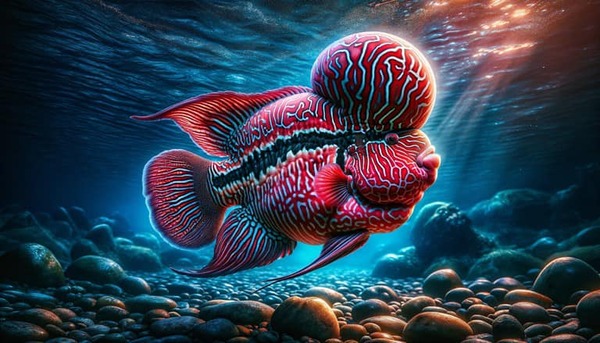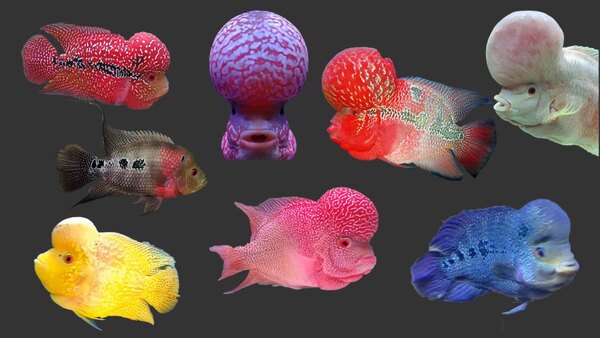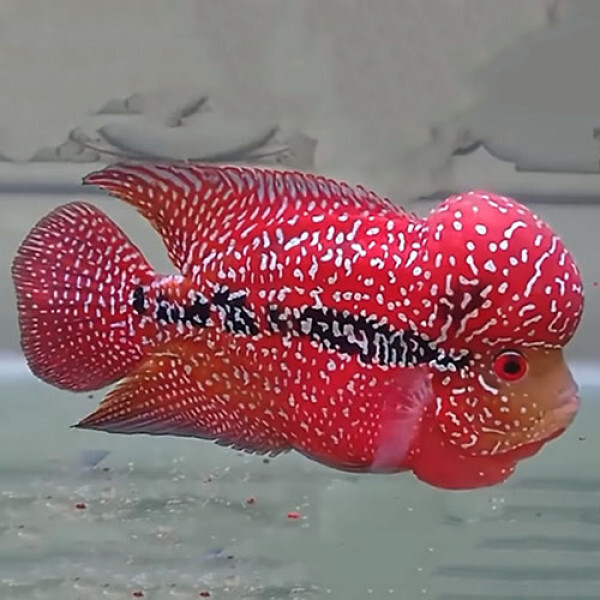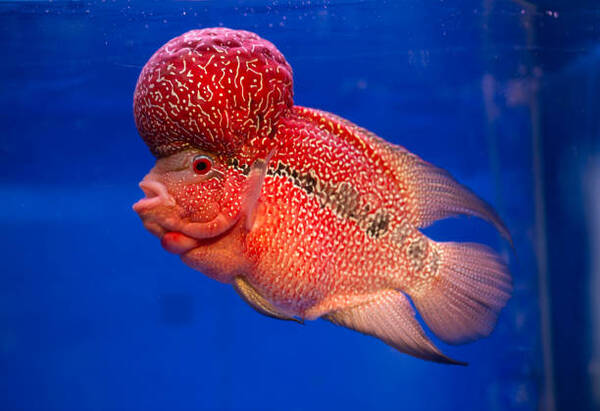The Flower Horn is a striking and popular aquarium fish known for its vibrant colors and distinctive appearance. With its large, rounded "hump" on its head, bright hues, and energetic personality, the Flower Horn has earned a reputation as one of the most eye-catching and beloved ornamental fish worldwide. In this article, we will explore what makes Flower Horns so unique, their origins, care requirements, and the best practices for keeping them as pets in your aquarium.

The Flower Horn is a type of hybrid fish that was specifically bred for ornamental purposes. Known for their unique and often exaggerated physical traits, Flower Horns have become one of the most popular fish among aquarium enthusiasts. The fish's most notable feature is the large, fleshy "hump" on its head, which becomes more pronounced as it matures. This bump, combined with their bright colors and large fins, gives them a very distinctive and attractive appearance.
While Flower Horns are often recognized by their "hump," they can also be known for their unique patterns and bold colorations, including shades of red, yellow, orange, and blue. Their appearance, combined with their personality, has made them a favorite for both beginners and experienced aquarists alike.
The Flower Horn fish was first bred in Malaysia during the late 20th century. It is a hybrid, created by crossbreeding several different cichlid species, such as the Midnight Cichlid, Red Devil Cichlid, Oscar, and Jaguar Cichlid. The goal of these crossbreeding efforts was to create a fish that was not only visually striking but also had an engaging and active temperament.
Over time, breeders have focused on developing Flower Horns with specific traits such as larger head humps, vibrant colors, and unique patterns. This selective breeding process has resulted in various strains of Flower Horns, each with different physical characteristics and colorations.
Flower Horns are easily recognizable by their:
Large head hump: The most iconic feature of Flower Horns is their pronounced, fleshy bump on their head, known as the "nuchal hump." This hump can grow larger as the fish matures, particularly in males. The size and shape of the hump can vary depending on the individual fish and the specific strain.
Bright colors: Flower Horns are known for their vivid, almost electric colors. Depending on the specific strain, they can be red, yellow, orange, and sometimes even blue. The colors can become more intense as the fish matures.
Flared fins: Flower Horns have long, flowing fins that give them a graceful appearance as they swim. Their tails and fins are often adorned with stunning patterns that add to their beauty.
Distinctive patterns: Each Flower Horn fish has a unique set of markings or patterns on its body. Some have intricate spots, stripes, or even floral-like patterns, which is how they got their name.
One of the most appealing aspects of the Flower Horn is its bold and energetic personality. Unlike many other aquarium fish, Flower Horns are known for being quite interactive with their owners. They are intelligent and can often recognize their owners, swimming to the front of the tank when they approach. Some Flower Horns can even be trained to eat from their owner's hand or follow basic commands.
Flower Horns are also known for their territorial and aggressive nature. They are best kept alone or with other robust, large fish that can handle their bold temperament. When kept with other fish, it is important to provide plenty of space in the tank to reduce the chances of aggression.
Flower Horns are relatively easy to care for but do require a few specific conditions to thrive. Here are some key points to consider when caring for a Flower Horn:
Tank Size: Flower Horns can grow quite large, reaching up to 12–16 inches (30–40 cm) in length. Therefore, they require a large tank, ideally 55 gallons (208 liters) or more, to provide ample swimming space. The larger the tank, the better, as this will help reduce aggression and give your Flower Horn the room it needs to grow and thrive.
Water Conditions: Flower Horns prefer slightly alkaline water with a pH level between 7.0 and 8.0. They also do best in water temperatures ranging from 78°F to 84°F (25°C to 29°C). Regular water changes and filtration are essential to maintaining a healthy environment for your Flower Horn.
Filtration: Due to their large size and active nature, Flower Horns produce a significant amount of waste. A strong filtration system is necessary to maintain good water quality and prevent the tank from becoming polluted.
Diet: Flower Horns are omnivores and will eat a variety of foods, including high-quality pellets, live or frozen foods like shrimp and worms, and plant-based foods like spinach and peas. It’s important to provide a balanced diet to keep your Flower Horn healthy and vibrant.
Tankmates: As mentioned earlier, Flower Horns can be aggressive, so it’s crucial to choose tankmates carefully. They are best kept alone or with large, hardy fish that can defend themselves if needed. Avoid keeping them with smaller or more passive species, as they may become targets for aggression.
Breeding Flower Horns can be a rewarding experience for experienced aquarists. When ready to breed, Flower Horns typically show changes in their behavior. Males will become more territorial, and females will exhibit more vibrant colors. The female Flower Horn lays eggs, which the male will fertilize. After the eggs hatch, the parents will protect their young and ensure that the fry are kept safe.
Breeding Flower Horns is not recommended for beginners, as it requires careful attention to water conditions, tank setup, and the behavior of the fish. Additionally, Flower Horns are known for their aggression, especially when they are guarding their eggs or young, so extra care should be taken during this time.

Flowerhorn fish are a hybrid species with a wide range of variations in terms of color, pattern, and overall appearance. The different types of Flowerhorns are often categorized by their distinctive features such as body shape, head size, and coloration. Below is a detailed table outlining the main types of Flowerhorn fish, along with their defining characteristics.
| Type | Description | Distinctive Features | Origin |
|---|---|---|---|
| Red Dragon Flowerhorn | Known for its vibrant red body and large, rounded nuchal hump (the prominent head bump). | Bright red color, large nuchal hump, high body shape, aggressive nature. | Crossbreeding in Southeast Asia |
| Kamfa Flowerhorn | Recognized for its bright and unique color combinations, often including reds, oranges, and yellows. | Round-shaped body, aggressive temperament, smaller nuchal hump compared to Red Dragon. | Thailand, Malaysia |
| Zhen Zhu (Pearl) Flowerhorn | Characterized by shimmering, pearl-like scales that cover its body. | Pearly sheen, smaller but noticeable nuchal hump, usually bright colors like red, yellow, or orange. | Malaysia, Thailand |
| King Kamfa Flowerhorn | One of the most sought-after types due to its striking color and large, distinct head. | Large nuchal hump, distinct black markings, golden-yellow or red-orange body, very aggressive. | Crossbreeding in Southeast Asia |
| Golden Monkey Flowerhorn | This variety has a golden-yellow coloration with a prominent nuchal hump. | Rich golden color, small to medium-sized nuchal hump, typically very territorial and aggressive. | Malaysia, Thailand |
| Tianjin Flowerhorn | Known for its consistent and bold color patterns, often featuring vibrant reds and blues. | Large and prominent nuchal hump, bright body color with distinct patterns, aggressive nature. | China (specifically Tianjin region) |
| Darth Vader Flowerhorn | A darker variety of Flowerhorn, often with black body color and contrasting bright markings. | Predominantly black body, often with yellow or red markings on its fins and body, large nuchal hump. | Southeast Asia |
| Midnight Flowerhorn | This type features darker hues and more subtle color contrasts than other Flowerhorns. | Darker body (often black or deep blue), bright nuchal hump, strong territorial instincts. | Southeast Asia |
| Banana Flowerhorn | A unique variety known for its yellow and orange tones, resembling the shape of a banana. | Yellow to orange body coloration, medium-sized nuchal hump, active and aggressive. | Crossbreeding in Southeast Asia |
| Tornado Flowerhorn | Features an exaggerated nuchal hump and a sleek body, often with dramatic patterns. | Large, distinct nuchal hump, deep red or orange coloration with contrasting black markings. | Thailand, Malaysia |
Head or Nuchal Hump: One of the most distinguishing features of Flowerhorns. A large nuchal hump often denotes a more prized specimen.
Color Patterns: While some types like the Red Dragon Flowerhorn have solid colors, others like the Zhen Zhu Flowerhorn have pearlescent or multi-colored scales.
Body Shape: Different types may have rounder bodies (like the Kamfa Flowerhorn) or more elongated shapes, depending on their genetic lineage.
Size: Flowerhorns can grow to be quite large, with some types reaching up to 12 inches (30 cm) in length.
Aggression: All Flowerhorns tend to have an aggressive temperament, but some types, like the King Kamfa Flowerhorn, are known to be particularly territorial.
These different varieties of Flowerhorn fish can be distinguished based on these characteristics, and their appeal to hobbyists often lies in their unique looks and the challenge of raising such vibrant, lively fish.
The price of a Flower Horn can vary depending on several factors, such as the size, color, and strain of the fish. On average, a Flower Horn can cost anywhere from $30 to $200 or more. The rarer and more vibrant the colors or patterns, the higher the price tag. Specially bred strains with large, prominent head humps or unique color patterns can sometimes fetch even higher prices.
Flower Horns are widely available in pet stores and from online fish breeders. However, due to their specific care requirements and sometimes aggressive nature, it's essential to buy from reputable breeders who prioritize the health and well-being of the fish.
The Flower Horn is a stunning and unique fish that can be an excellent addition to any aquarium, particularly for those who enjoy an active and engaging pet. With their vibrant colors, distinctive head hump, and interactive personality, Flower Horns are sure to make a lasting impression in your aquarium. While they require a bit more attention and care than some other fish, the rewards of keeping a healthy and happy Flower Horn are more than worth it. Whether you're a seasoned aquarist or just getting started, this beautiful fish is sure to be a fascinating addition to your collection.

The Flower Horn fish gets its name from the unique and striking "flower-like" patterns that can be seen on its body, particularly around the head area. The name "Flower Horn" also refers to the prominent nuchal hump or "head bump," which is one of the fish's most defining features. The hump, which resembles a "flower" shape when viewed from certain angles, contributes to the fish's overall appearance and appeal. This combination of bold colors and unique head structure has made the Flower Horn one of the most popular ornamental fish species globally.
Flower Horns are hybrid fish, which means they are created by crossbreeding several different species of cichlids. The primary species used in the breeding process are:
Midnight Cichlid (Paraneetroplus synspilus)
Red Devil Cichlid (Amphilophus citrinellus)
Oscar Fish (Astronotus ocellatus)
Jaguar Cichlid (Parachromis managuensis)
These cichlids were intentionally crossbred by fish breeders, starting in the late 20th century in Malaysia, with the goal of producing a fish that was both visually striking and had an engaging personality. Over time, different strains of Flower Horns have been developed, each with its own specific color patterns, size, and head hump characteristics.
The average lifespan of a Flower Horn fish is about 10 to 12 years, though with optimal care, they can live even longer. Their lifespan can be influenced by factors like the quality of the water, diet, tank conditions, and how well the fish is maintained. Regular water changes, a balanced diet, and avoiding stressors can help prolong the Flower Horn's life and ensure it remains healthy.
Breeding Flower Horns can be a rewarding but challenging experience. Flower Horns are known for their territorial behavior and aggression, especially when they are in breeding condition. Here’s a basic outline of how the breeding process works:
Mating Behavior: When ready to breed, males will develop more vibrant colors and larger head humps. Females may exhibit a more rounded belly when they are carrying eggs.
Egg Laying: The female will lay her eggs, usually on a flat surface like a rock or the side of the aquarium. The male will fertilize the eggs immediately after they are laid.
Care for Fry: Once the eggs hatch, the parents protect the young and defend them from any threats. Flower Horn parents are known to be protective of their offspring, keeping them safe in the early stages of their development.
Raising the Fry: The fry grow quickly and need proper care, including clean water, adequate space, and the right type of food for their size. Fry may be separated from the parents once they are big enough to fend for themselves.
Flower Horn breeding is typically done in large, well-maintained tanks to accommodate the territorial behavior and ensure the health of both the parents and the fry.
Flower Horns are territorial and aggressive, so it is crucial to choose their tank mates carefully. Here are some general guidelines for keeping Flower Horns with other fish:
Large, Hardy Fish: Flower Horns do best with other large, robust fish that can handle their aggressive nature. Examples include Cichlids, Oscars, and Jaguar Cichlids (their relatives).
Avoid Small Fish: Small or peaceful species like tetras, guppies, and bettas are not suitable tank mates for Flower Horns, as they may become targets for aggression.
Space Is Important: Providing plenty of space and hiding spots can reduce conflict. Flower Horns require large tanks (55 gallons or more) to accommodate their size and aggression.
Some fish enthusiasts prefer to keep Flower Horns in a species-only tank to avoid territorial disputes.
Flower Horns can make good pets for experienced aquarists, but they may not be the best choice for beginners. Here’s why:
Interactive: Flower Horns are highly intelligent and can be trained to recognize their owners. They often swim to the front of the tank when their owners approach and may even eat from their hands.
Personality: Flower Horns have strong personalities, and they are known for being curious, active, and sometimes aggressive. They can make great pets for those who enjoy an energetic fish with a lot of character.
Care Requirements: They require larger tanks, a well-maintained filtration system, and proper water parameters to thrive. Their diet needs to be balanced, and they are best kept in an environment where they can grow and develop properly.
Aggressive Nature: Flower Horns can be territorial and aggressive, especially during breeding. If you're looking for a peaceful aquarium, they might not be the ideal choice. However, with proper care and the right tank mates, Flower Horns can coexist peacefully in a well-managed aquarium
The Flower Horn is a fascinating and visually striking aquarium fish, known for its unique appearance and engaging personality. They are hybrid cichlids, created by crossbreeding several different fish species, and they have become a beloved choice for many aquarists. While they require a bit more care and attention than other types of fish, Flower Horns can make wonderful pets for those who are prepared to meet their needs. With their bright colors, large head humps, and active nature, Flower Horns can truly be the centerpiece of any aquarium.

Flower Horns are stunning, vibrant fish that are known for their bold colors and unique personalities. Keeping them as pets can be incredibly rewarding, but they require special care due to their size, aggression, and specific environmental needs. Here’s a detailed guide on how to properly care for a Flower Horn fish:
Flower Horns are large fish that can grow up to 12-16 inches (30-40 cm), so they need a spacious tank. Here’s what to consider:
Tank Size: The minimum tank size for a single Flower Horn should be 55 gallons (208 liters). A larger tank, like 75 gallons (284 liters), is even better, especially if you plan to house other fish with it.
Water Filtration: Flower Horns produce a lot of waste, so a high-quality filtration system is essential. A powerful filter will help maintain clean and clear water, which is crucial for their health.
Substrate: Use fine gravel or smooth sand at the bottom of the tank. Flower Horns like to dig and root around, so the substrate should be safe for them.
Decorations: Add rock formations, driftwood, or plastic plants that can serve as hiding spots and provide them with some structure. Avoid sharp objects that could damage their sensitive skin.
Water Parameters: Flower Horns prefer warm, slightly acidic to neutral water. The ideal water temperature is 80-85°F (27-29°C), and the pH should be around 6.5-7.5.
Maintaining high water quality is essential to keeping your Flower Horn healthy.
Regular Water Changes: Flower Horns are messy eaters, so water changes should be done regularly to keep the tank clean. Aim for a 20-30% water change every week.
Water Testing: Regularly test the water for ammonia, nitrites, and nitrates, especially since Flower Horns produce a lot of waste. The ammonia and nitrite levels should be at 0 ppm, and nitrates should be kept below 20 ppm.
Aeration: Flower Horns require well-oxygenated water, so a good aerator or filter that creates surface agitation will help keep the water oxygenated.
Flower Horns are carnivorous and need a high-protein diet to stay healthy and vibrant. Here’s how to feed them:
Pellets: High-quality cichlid pellets are a staple for Flower Horns. Look for a pellet that contains high levels of protein and is designed for large cichlids.
Live/Frozen Foods: Flower Horns love live or frozen foods, including bloodworms, shrimp, and krill. These foods help promote their natural hunting instincts and provide additional nutrition.
Vegetables: While they are carnivores, you can occasionally offer them some vegetables, such as blanched spinach, peas, or zucchini, to provide additional nutrients.
Feeding Frequency: Flower Horns should be fed 2-3 times a day, and it’s important not to overfeed. Feed only what they can eat in 5 minutes to avoid water contamination from uneaten food.
Flower Horns are territorial and aggressive, so choosing tank mates carefully is essential:
Single Tank: Many Flower Horn owners choose to keep them in a species-only tank to avoid aggression.
Large, Robust Fish: If you want to add other fish, consider other large, aggressive cichlids, such as Oscars, Jaguar Cichlids, or Texas Cichlids. Avoid small fish or peaceful species like neon tetras.
Avoid Small Fish: Smaller or slower fish will likely become targets for bullying or even be eaten by the Flower Horn.
Tank Size: If you do have other fish, make sure the tank is large enough to accommodate multiple fish, ideally over 75 gallons.
Lighting: Flower Horns don’t require special lighting, but a standard aquarium light will help bring out their colors and highlight their unique features. A regular 12-hour light cycle is recommended.
Temperature: Keep the water temperature at 80-85°F (27-29°C), as Flower Horns are tropical fish and thrive in warmer water. A heating pad or aquarium heater is essential for maintaining consistent temperatures.
Flower Horns are generally hardy, but like all fish, they can suffer from diseases if not properly cared for. Here are some tips for keeping them healthy:
Monitor Behavior: Watch for any changes in behavior, such as lethargy, loss of appetite, or abnormal swimming patterns. These can be early signs of illness.
Common Diseases: Flower Horns are prone to some common fish diseases, including Ich (white spot disease), fin rot, and hole-in-the-head disease. Regular water changes and maintaining good water quality can help prevent these issues.
Stress: Flower Horns can become stressed if they feel threatened, especially when they are housed with tank mates that are too small or shy. Stress can lead to weakened immunity, making them more susceptible to disease.
Breeding Flower Horns requires a well-established pair and a proper breeding setup. Here's what you need to know:
Mature Pair: To breed Flower Horns, you need a mature male and female. The male will develop a larger head hump, while the female’s belly will become rounder as she carries eggs.
Breeding Tank: Set up a separate breeding tank with a flat surface for the female to lay eggs on. Make sure the water quality and temperature are optimal for breeding.
Parental Care: Flower Horns are known to be protective parents. The female will lay the eggs, and the male will fertilize them. Once hatched, both parents will guard and protect the fry until they are large enough to swim on their own.
Flower Horns are highly interactive and can develop a bond with their owners:
Recognizing Owners: Flower Horns are intelligent and can recognize their owners. They may swim to the front of the tank or beg for food when they see you approaching.
Training: You can train them to follow your finger or even eat directly from your hand with time and patience.
Temperament: Despite their territorial nature, many Flower Horns are curious and active, making them an exciting and engaging pet to have in your aquarium.
Keeping a Flower Horn requires dedication, but with the right care, they can thrive and become a captivating centerpiece in your aquarium. They need a large tank, clean water, a high-protein diet, and careful management of tank mates. Their unique appearance and engaging personalities make them great pets for experienced aquarists who can handle their aggression and territorial behaviors. By providing them with a suitable environment and proper attention, your Flower Horn can live a long, healthy, and happy life.
animal tags: Flower-Horn
We created this article in conjunction with AI technology, then made sure it was fact-checked and edited by a Animals Top editor.